For the second year running, in-person Fleet Week in New York, traditionally beginning in the week before and running through the Memorial Day Weekend, was canceled due to the Covid-19 pandemic. A virtual Fleet Week celebration has been ongoing, however, on Facebook, Twitter, and Instagram. Below is a short view about this year’s virtual New York Fleet Week.
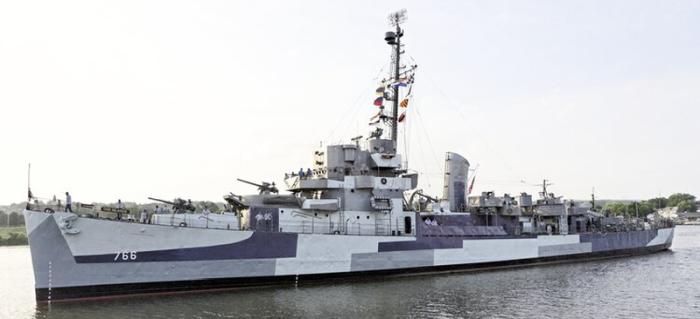 Museum ships are slowly reopening. The USS Slater on the Albany waterfront, the last Destroyer Escort afloat in America, is set to open to the public on Memorial Day, Monday, May 31st. After Memorial Day the ship will operate normal hours Wednesday through Sunday, from 10 am to 4 pm.
Museum ships are slowly reopening. The USS Slater on the Albany waterfront, the last Destroyer Escort afloat in America, is set to open to the public on Memorial Day, Monday, May 31st. After Memorial Day the ship will operate normal hours Wednesday through Sunday, from 10 am to 4 pm.
Guided tours take place every 30 minutes. All visitors and volunteers are required to wear a mask while aboard Slater. Tour groups will be kept small, and the ship will be disinfected regularly. No reservations are required.
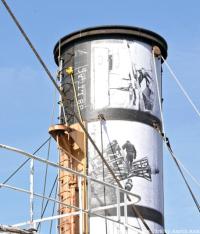 The historic lighthouse tender USCGC Lilac recently turned 88. Lilac is America’s only surviving steam-powered lighthouse tender and is listed on the National Register of Historic Places.
The historic lighthouse tender USCGC Lilac recently turned 88. Lilac is America’s only surviving steam-powered lighthouse tender and is listed on the National Register of Historic Places.
To celebrate her birthday, two temporary art installations featuring historic photography and dramatic audio have been set up. LILAC 88 consists of an onboard paper mural to celebrate the history of the Lilac on Pier 25 in Lower Manhattan. This paper mural displays large-scale historic images displayed on the ship’s stack in order to make the ship visible from afar and attract public attention to the Lilac over the Memorial Day holiday.
The audio installation, “Aids to Navigation” is a dramatic composition by Untapped New York’s Chief Experience Officer Justin Rivers. It centers around the ship’s second commander, Captain Charles Lewis and is intended to serve as a mini-dramatic tour of Lilac. Captain Lewis is voiced by actor Robert Dalton and the audio piece was directed and mixed by director, Michael Joseph Ormond. The public will be able to access the experience via a QR code near the stern of the boat and can enjoy the entire installation from Pier 25. To listen to “Aids to Navigation” online, click here.
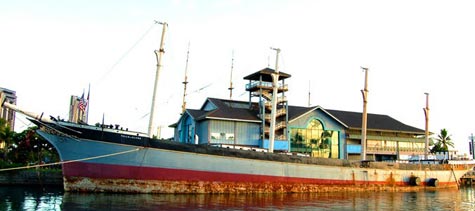
The Falls of Clyde, the only remaining iron-hulled four-masted full-rigged ship and the only surviving sail-driven oil tanker in the world, has been given a short reprieve from being scrapped or scuttled.
In late April, the Hawaii Department of Transportation’s Harbors Division put out a request for proposals for the “removal of the derelict sailing vessel Falls of Clyde from Honolulu Harbor.” The bids were due at 10 a.m. on Friday, May 21.
The Department of Transportation has now revoked the request for proposal to remove the ship. The DOT said in a review, “it turns out that not all state processes are upheld.” Therefore, the RFP was canceled “with great care.”
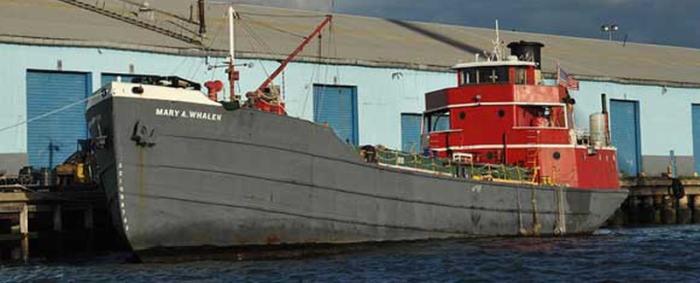 PortSide NewYork is hosting a fascinating virtual talk with Captain Lawrence Brennan, a Fordham law Professor, and PortSide Executive Director Carolina Salguero about the Supreme Court decision US vs RELIABLE TRANSFER involving PortSide’s historic ship Mary A. Whalen. Brennan and Salguero will be on the Mary A. Whalen together, allowing you to see some of the ship.
PortSide NewYork is hosting a fascinating virtual talk with Captain Lawrence Brennan, a Fordham law Professor, and PortSide Executive Director Carolina Salguero about the Supreme Court decision US vs RELIABLE TRANSFER involving PortSide’s historic ship Mary A. Whalen. Brennan and Salguero will be on the Mary A. Whalen together, allowing you to see some of the ship.
The talk will be on Zoom on Thursday, June 10, 2021, from to This virtual lunchtime presentation is tailored to a general audience and landlubbers, not just admiralty lawyers. There will be several opportunities for Q&A.
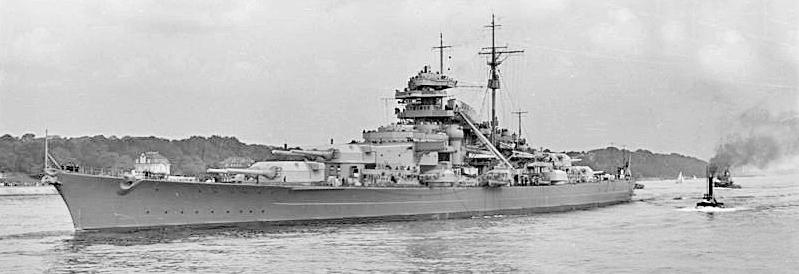
Bismarck
On the evening of May 26, 1941, eighty years ago today, a squadron of obsolete biplanes flown by volunteer pilots succeeded in crippling the Bismarck, the mightiest battleship in the German Kriegsmarine. A revised repost.
The Bismarck was about to escape to the safety of Brest in occupied France. Two days before, in the Battle of Denmark Strait, the German battleship sank the British battle cruiser HMS Hood in six minutes. Then, after a chase of several days, pursued by a large British flotilla, the Bismarck was about to get away.
On the stormy evening of May 26, in heavy seas and only an hour’s worth of daylight left to stop the German ship, a squadron of fifteen Fairey Swordfish biplanes was launched from the carrier HMS Ark Royal. The pilots of the Swordfish biplanes were all members of the Royal Naval Volunteer Reserve, a corps of civilian volunteers who served alongside Royal Navy and Royal Navy Reserve personnel. The wavy stripes on RNVR officers’ sleeves differentiated them from RN/RNR officers, and gave the group the nickname, the “Wavy Navy.”
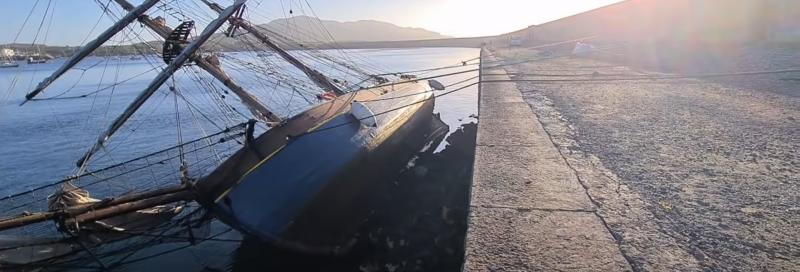 Attempts to salvage the historic tall ship Zebu have failed. Last week, the 100′ long brigantine, built in Sweden in 1938, broke from its moorings and drifted onto the Holyhead New Harbour breakwater in Wales, where she became hard aground. Attempts to save the ship were thwarted by a storm that hit Holyhead on Friday, with winds of up to 70 miles per hour, subjecting the already damaged ship to a horrendous pounding by both wind and sea. Zebu suffered further devastating damage in the storm. The captain then had to make the difficult decision to declare Zebu a wreck. Nature had now had the final say.
Attempts to salvage the historic tall ship Zebu have failed. Last week, the 100′ long brigantine, built in Sweden in 1938, broke from its moorings and drifted onto the Holyhead New Harbour breakwater in Wales, where she became hard aground. Attempts to save the ship were thwarted by a storm that hit Holyhead on Friday, with winds of up to 70 miles per hour, subjecting the already damaged ship to a horrendous pounding by both wind and sea. Zebu suffered further devastating damage in the storm. The captain then had to make the difficult decision to declare Zebu a wreck. Nature had now had the final say.
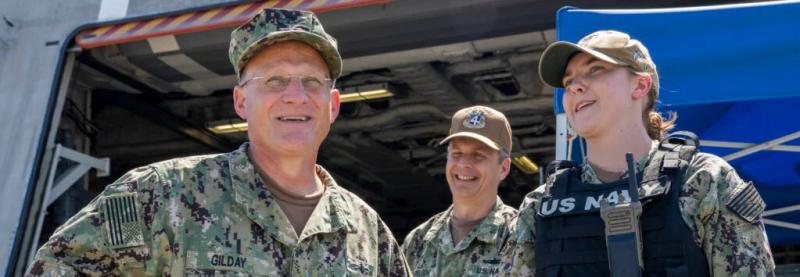
Chief of Naval Operations Adm. Mike Gilday aboard the littoral combat ship USS Detroit
In January of this year, while speaking before the annual Surface Navy Association symposium, US Chief of Naval Operations Adm. Mike Gilday was blunt. He said, “I don’t mean to be dramatic, but I feel like if the Navy loses its head, if we go off course and we take our eyes off those things we need to focus on, I think we may not be able to recover in this century.”
Now, as the Biden administration readies a Navy budget proposal this week to send to lawmakers. Adm. Gilday insists that the Navy is on a “positive trajectory” but that it will have to rebuild confidence under congressional scrutiny as it prepares a new strategic plan that’ll include another long-term investment: unmanned vehicles.
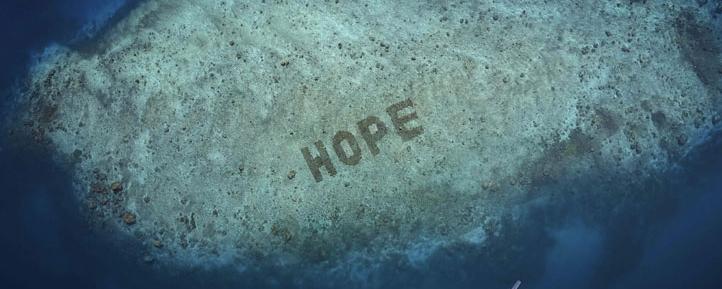 What does cat food have to do with coral reefs? Mars Petcare catfood brand SHEBA® has partnered with The Nature Conservancy to develop what it claims is the world’s largest coral restoration program, expected to cover more than 185,000 square meters around the world by the end of 2029.
What does cat food have to do with coral reefs? Mars Petcare catfood brand SHEBA® has partnered with The Nature Conservancy to develop what it claims is the world’s largest coral restoration program, expected to cover more than 185,000 square meters around the world by the end of 2029.
Earlier this month, the partner organizations unveiled the first images and videos of ‘Sheba Hope Reef’, the starting location for the global initiative. Work to restore the reef, off the coast of Sulawesi, Indonesia, began two years ago and, in that time, coral cover has increased from, 5% to 55%. The reef, which can be seen on Google Earth, has been built to spell the word H-O-P-E and is intended as a symbol to show the world how positive change can happen within our lifetime.
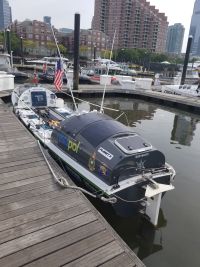 While getting our boat ready to move to her summer mooring, I had the good fortune to meet Ian Clinton and Simon Chalk, members of the Ocean Revival Adventures crew, waiting with their ocean rowing boats at Liberty Landing in New York harbor for a suitable weather window to set off on what has been dubbed the “world’s most dangerous row.”
While getting our boat ready to move to her summer mooring, I had the good fortune to meet Ian Clinton and Simon Chalk, members of the Ocean Revival Adventures crew, waiting with their ocean rowing boats at Liberty Landing in New York harbor for a suitable weather window to set off on what has been dubbed the “world’s most dangerous row.”
From their website: Ocean Revival 2020 is a team of serving and former serving Royal Marine Commandos, who have fought alongside each other in 45 Commando. They have now teamed up to take the fight against plastic by rowing across the North Atlantic Ocean, rowing a route that has never been completed before and one that is statistically the most dangerous and arduous ocean row to attempt.
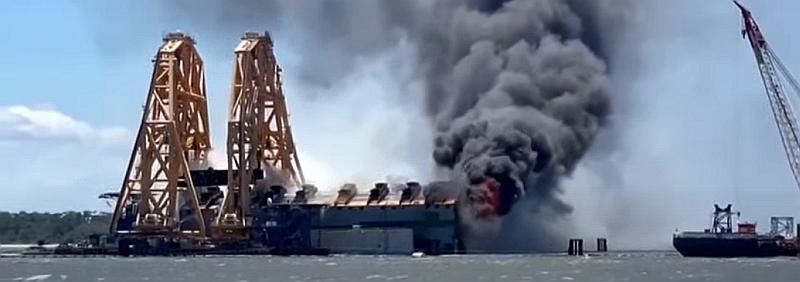 The salvage job to remove the car carrier Golden Ray that rolled on its side as it departed the Port of Brunswick, GA, in September 2019 while carrying about 4,200 vehicles, was originally planned to take around eight weeks and to be finished by last Christmas. Now, months behind schedule, the project continues to face new challenges. Salvors using cutting torches sparked a significant fire last Friday that wasn’t extinguished until Monday. There were no reported injuries to the salvors or firefighters.
The salvage job to remove the car carrier Golden Ray that rolled on its side as it departed the Port of Brunswick, GA, in September 2019 while carrying about 4,200 vehicles, was originally planned to take around eight weeks and to be finished by last Christmas. Now, months behind schedule, the project continues to face new challenges. Salvors using cutting torches sparked a significant fire last Friday that wasn’t extinguished until Monday. There were no reported injuries to the salvors or firefighters.
Marine Log reports that naval architects and response engineers are assessing the fire’s impact on the structure of the remaining wreck and the custom-fabricated lifting structures welded to its top. Meantime, wreck removal personnel continue to assess, repair, and replace equipment on the VB-10000 heavy lift vessel.
 Supporters in Scotland are mounting a last-ditch effort to save the Falls of Clyde from scrapping or scuttling in Hawaii. The Falls of Clyde, launched in 1878 in Port Glasgow, Scotland, is the only remaining iron-hulled four-masted full-rigged ship and the only surviving sail-driven oil tanker in the world.
Supporters in Scotland are mounting a last-ditch effort to save the Falls of Clyde from scrapping or scuttling in Hawaii. The Falls of Clyde, launched in 1878 in Port Glasgow, Scotland, is the only remaining iron-hulled four-masted full-rigged ship and the only surviving sail-driven oil tanker in the world.
In late April, the Hawaii Department of Transportation’s Harbors Division put out a request for proposals for the “removal of the derelict sailing vessel Falls of Clyde from Honolulu Harbor.” The bids are due at 10 a.m. Friday.
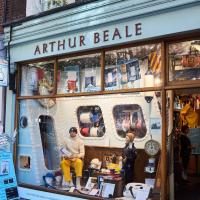
London’s yacht-chandler Arthur Beale will close its doors on June 24, after being in business for more than 500 years. Located on Shaftesbury Avenue, in what is now London’s West End, the store is shutting down due to high rents and the impact of the pandemic.
Originally founded by rope-maker, John Buckinghams, sometime around 1500, no one knows how old the business is exactly. In 1890, Arthur Beale joined the company as an office boy. The shop was re-named after him in the early 1900s.
 Chad Kālepa Baybayan, a revered Hawaiian navigator and captain of the Polynesian voyaging canoe Hōkūleʻa, died on April 8 while visiting family in Seattle. He was 64. His daughter Kala Tanaka said the cause was a heart attack.
Chad Kālepa Baybayan, a revered Hawaiian navigator and captain of the Polynesian voyaging canoe Hōkūleʻa, died on April 8 while visiting family in Seattle. He was 64. His daughter Kala Tanaka said the cause was a heart attack.
Chad Kalepa Baybayan, part of the Hawaiian renaissance of Polynesian voyaging, was one of only five Hawaiians along with 11 Micronesians initiated in 2007 into Pwo, a 2,000-year-old society of deep-sea navigators, by Master Navigator Mau Piailug of Satawal.
Beginning in the late 1970s, Baybayan sailed on Hokule’a for more than 40 years. He also served as captain and navigator on the voyaging canoes Hawaiiloa and Hokualakai. He sailed on major voyages in the South Pacific, the West Coast of North America, Micronesia, and Japan.
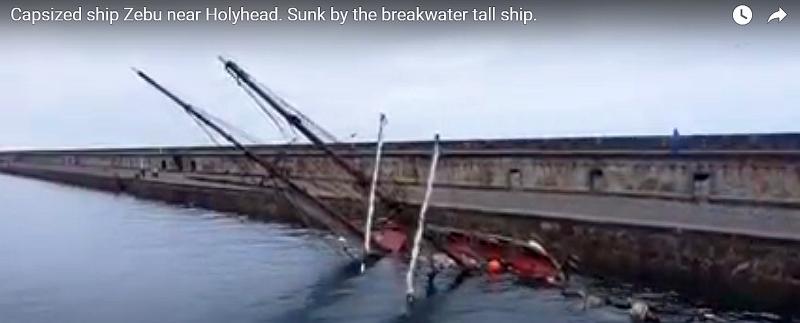 This has been a terrible few days for the historic tall ship Zebu. On Thursday, the 100′ long brigantine, built in Sweden in 1938, encountered unspecified difficulties and had to be towed out of shipping lanes off Wales by the Royal National Lifeboat Institution (RNLI). The ship was towed to an anchorage at Holyhead.
This has been a terrible few days for the historic tall ship Zebu. On Thursday, the 100′ long brigantine, built in Sweden in 1938, encountered unspecified difficulties and had to be towed out of shipping lanes off Wales by the Royal National Lifeboat Institution (RNLI). The ship was towed to an anchorage at Holyhead.
On Saturday, the ship broke from its moorings and drifted onto the Holyhead New Harbour breakwater, where she became hard aground. A rescue mission was launched by HM Coastguards’ Maritime Rescue Co-ordination Centre – but was ultimately unsuccessful. The ship heeled over as the tide fell, rolling more than 45 degrees and subsequently flooding.

The Dutch shipyard Neptune Marine has begun construction of the sailing cargo vessel Canopée, which will transport Ariane 6 rockets from Europe to the launch site in Kourou in French Guyana. The ship will feature 1,500 square meter sails to lower fuel consumption and emissions.
The cutting of steel was started just before last Christmas and the first bottom sections are under construction. The outfitting completion will be executed at Neptune Hardinxveld. Delivery of the vessel is scheduled end of 2022 after a series of trials and tests.
 The Mary Rose, often described as King Henry VIII’s favorite warship, sank on July 19, 1545 during the Battle of the Solent with the loss of most of its crew of 415. When the ship was raised in 1982, the remains of at least 179 crew members were discovered, together with thousands of objects ranging from weaponry to tools and games. Many of the crew’s skeletal remains were found to be well preserved, allowing scientists to investigate the backgrounds of the crew.
The Mary Rose, often described as King Henry VIII’s favorite warship, sank on July 19, 1545 during the Battle of the Solent with the loss of most of its crew of 415. When the ship was raised in 1982, the remains of at least 179 crew members were discovered, together with thousands of objects ranging from weaponry to tools and games. Many of the crew’s skeletal remains were found to be well preserved, allowing scientists to investigate the backgrounds of the crew.
A recent study by researchers from Cardiff University, the Mary Rose Trust, and the British Geological Survey, published in the journal Royal Society Open Science, used a technique called multi-isotope analysis on teeth to investigate where eight crew members spent their early years. The results suggest significant ethnic diversity in the Tudor Navy.
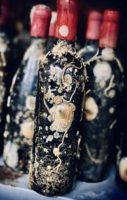
Retrieved submerged bottles of Ocean Fathoms wine.
Image: Lara Castaognia
A new craze is spreading across the world of wine. Call it “shipwreck wine” without the shipwreck. Off the shores of California, Croatia, Spain, Britain, France, Argentina, Italy, and China; vintners are aging wines underwater in specially constructed ocean wine cellars. They report that the ocean-aged wines mature faster and, depending on the wine, were brighter and fruitier. The near-constant cool temperature underwater coupled with the total lack of oxygen is credited with the improved quality of the wine when it emerges from the briny deep.
The underwater wine cellars around the globe were inspired by the discovery of a shipwreck in the Baltic in 2010. In the wreck’s hold, divers found 30 bottles of champagne thought to pre-date the French Revolution on the Baltic seabed. Remarkably, the champagne was still highly drinkable. When the Baltic bubbly sold at auction, a bottle of Veuve Clicquot, believed to date from between 1782 and 1788, went for 30,000 euros or roughly $43,500.
 May is Asian American and Pacific Islander Heritage Month, so it seems appropriate to remember the life and accomplishments of Susan Ahn Cuddy, a Korean American who would serve as the first female Asian-American officer in the US Navy and would also become the first female Navy gunnery instructor.
May is Asian American and Pacific Islander Heritage Month, so it seems appropriate to remember the life and accomplishments of Susan Ahn Cuddy, a Korean American who would serve as the first female Asian-American officer in the US Navy and would also become the first female Navy gunnery instructor.
After leaving the Navy at the end of World War II, Cuddy also worked as an intelligence analyst and section chief at the National Security Agency and ran a think tank during the Cold War. She worked on top-secret projects for the Defense Department and supervised more than 300 scholars and experts in Russian affairs.
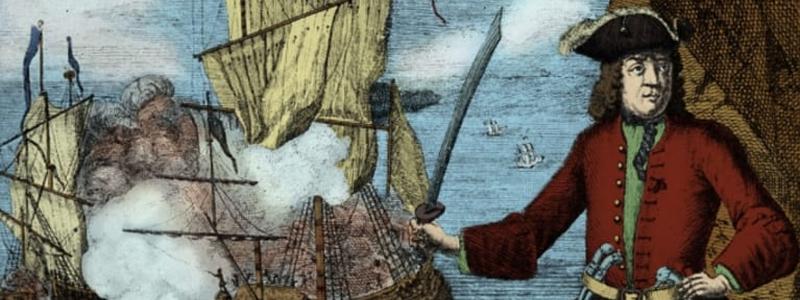 During the “Golden Age of Piracy,” the most successful pirates amassed huge fortunes over short periods of time and then died bloody deaths in combat, on the gallows, or in shipwrecks. The one notable exception was Captain Henry Every. During just two years prowling the seas, Every and his band captured roughly a dozen vessels and made off with tens of millions of dollars in booty.
During the “Golden Age of Piracy,” the most successful pirates amassed huge fortunes over short periods of time and then died bloody deaths in combat, on the gallows, or in shipwrecks. The one notable exception was Captain Henry Every. During just two years prowling the seas, Every and his band captured roughly a dozen vessels and made off with tens of millions of dollars in booty.
His exploits inspired songs, books and plays, including one called “The Successful Pyrate” that was performed on London stages for several years. Most astonishing of all—and unlike Blackbeard and many others—he did it all without getting captured or killed.
For a time, he was the most wanted criminal in the world for his plundering of a Mughal treasure fleet in 1695, yet he seemed to simply have vanished. Discoveries of Arabian coins found in Rhode Island, Massachusetts, Connecticut, and North Carolina suggest that Captain Every and his crew may have found refuge in the British North American colonies.
